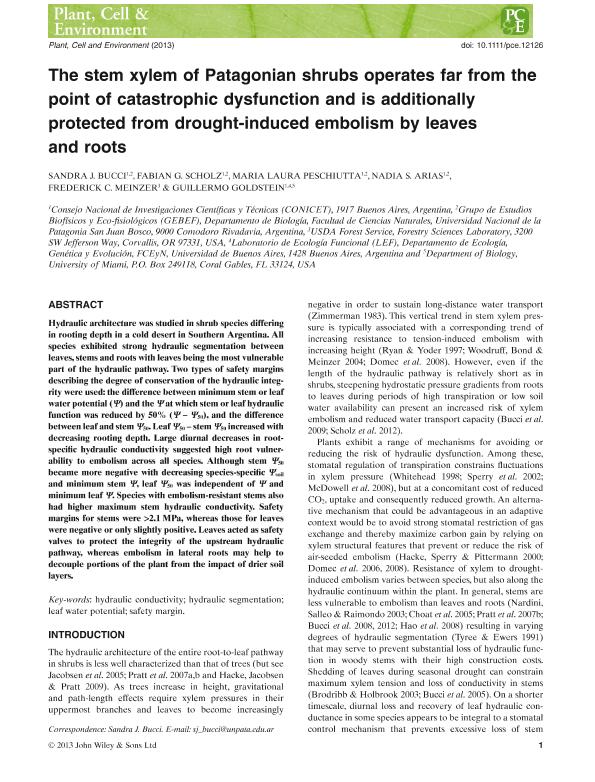Mostrar el registro sencillo del ítem
dc.contributor.author
Bucci, Sandra Janet

dc.contributor.author
Scholz, Fabian Gustavo

dc.contributor.author
Peschiutta, María Laura

dc.contributor.author
Arias, Nadia Soledad

dc.contributor.author
Meinzer, Frederick
dc.contributor.author
Goldstein, Guillermo Hernan

dc.date.available
2016-09-09T13:50:55Z
dc.date.issued
2013-03
dc.identifier.citation
Bucci, Sandra Janet; Scholz, Fabian Gustavo; Peschiutta, María Laura; Arias, Nadia Soledad; Meinzer, Frederick; et al.; The stem xylem of Patagonian shrubs operates far from the point of catastrophic dysfunction and is additionally protected from drought- induced embolism by leaves and roots; Wiley; Plant, Cell And Environment; 36; 12; 3-2013; 2163-2174
dc.identifier.issn
0140-7791
dc.identifier.uri
http://hdl.handle.net/11336/7575
dc.description.abstract
Hydraulic architecture was studied in shrub species differing in rooting depth in a cold desert in Southern Argentina. All species exhibited strong hydraulic segmentation between leaves, stems and roots with leaves being the most vulnerable part of the hydraulic pathway. Two types of safety margins describing the degree of conservation of the hydraulic integrity were used: the difference between minimum stem or leaf water potential (⍦) and the ⍦ at which stem or leaf hydraulic function was reduced by 50% ⍦ - ⍦50), and the difference between leaf and stem ⍦50. Leaf ⍦50 -⍦ stem ⍦50 increased with decreasing rooting depth. Large diurnal decreases in rootspecific hydraulic conductivity suggested high root vulnerability to embolism across all species. Although stem ⍦50 became more negative with decreasing species-specific Ysoil and minimum stem⍦, leaf ⍦50 was independent of ⍦ and minimum leaf ⍦. Species with embolism-resistant stems also had higher maximum stem hydraulic conductivity. Safety margins for stems were >2.1 MPa, whereas those for leaves were negative or only slightly positive. Leaves acted as safety valves to protect the integrity of the upstream hydraulic pathway, whereas embolism in lateral roots may help to decouple portions of the plant from the impact of drier soil layers.
dc.format
application/pdf
dc.language.iso
eng
dc.publisher
Wiley

dc.rights
info:eu-repo/semantics/openAccess
dc.rights.uri
https://creativecommons.org/licenses/by-nc-sa/2.5/ar/
dc.subject
Hydraulic Conductivity
dc.subject
Hydraulic Segmentation
dc.subject
Leaf Water Potential
dc.subject
Safety Margin
dc.subject.classification
Ecología

dc.subject.classification
Ciencias Biológicas

dc.subject.classification
CIENCIAS NATURALES Y EXACTAS

dc.title
The stem xylem of Patagonian shrubs operates far from the point of catastrophic dysfunction and is additionally protected from drought- induced embolism by leaves and roots
dc.type
info:eu-repo/semantics/article
dc.type
info:ar-repo/semantics/artículo
dc.type
info:eu-repo/semantics/publishedVersion
dc.date.updated
2016-09-05T13:21:55Z
dc.journal.volume
36
dc.journal.number
12
dc.journal.pagination
2163-2174
dc.journal.pais
Reino Unido

dc.journal.ciudad
Londres
dc.description.fil
Fil: Bucci, Sandra Janet. Consejo Nacional de Investigaciones Científicas y Técnicas; Argentina. Universidad Nacional de la Patagonia "San Juan Bosco"; Argentina
dc.description.fil
Fil: Scholz, Fabian Gustavo. Consejo Nacional de Investigaciones Científicas y Técnicas; Argentina. Universidad Nacional de la Patagonia "San Juan Bosco"; Argentina
dc.description.fil
Fil: Peschiutta, María Laura. Consejo Nacional de Investigaciones Científicas y Técnicas; Argentina. Universidad Nacional de la Patagonia "San Juan Bosco"; Argentina
dc.description.fil
Fil: Arias, Nadia Soledad. Universidad Nacional de la Patagonia "san Juan Bosco". Facultad de Ingenieria - Sede Comodoro; Argentina. Consejo Nacional de Investigaciones Científicas y Técnicas; Argentina
dc.description.fil
Fil: Meinzer, Frederick. United States Department of Agriculture; Estados Unidos
dc.description.fil
Fil: Goldstein, Guillermo Hernan. University Of Miami; Estados Unidos. Universidad de Buenos Aires. Facultad de Ciencias Exactas y Naturales. Departamento de Ecología, Genética y Evolución. Laboratorio de Ecología Funcional; Argentina
dc.journal.title
Plant, Cell And Environment

dc.relation.alternativeid
info:eu-repo/semantics/altIdentifier/doi/http://dx.doi.org/10.1111/pce.12126
dc.relation.alternativeid
info:eu-repo/semantics/altIdentifier/url/http://onlinelibrary.wiley.com/doi/10.1111/pce.12126/full
Archivos asociados
